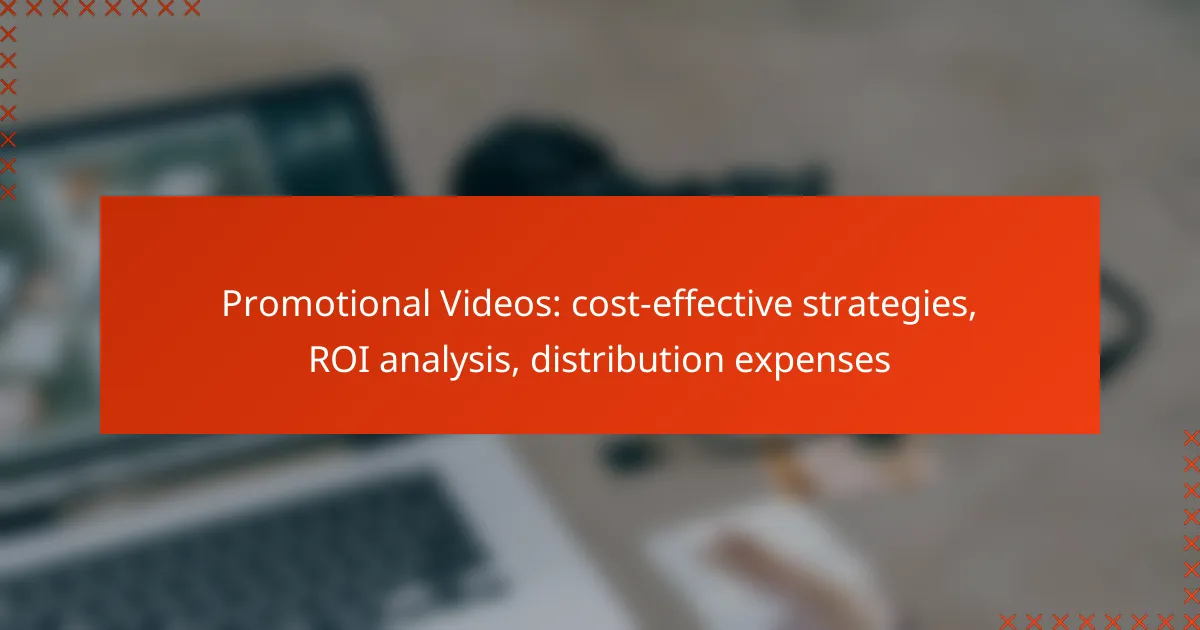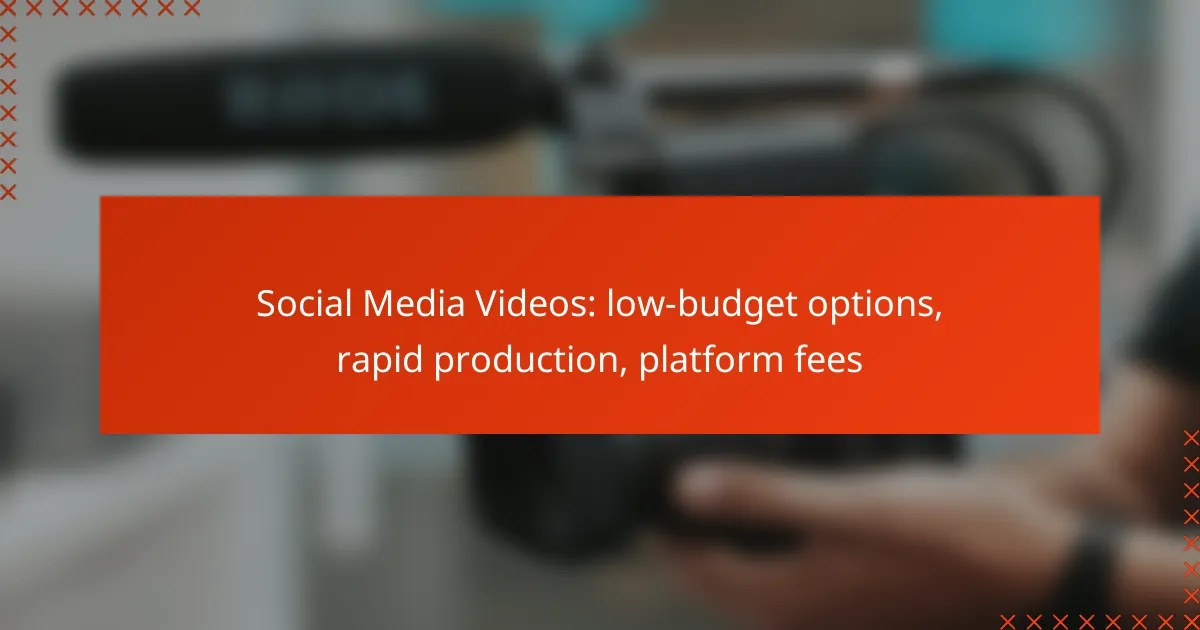Promotional videos can be a powerful tool for businesses, but implementing cost-effective strategies is essential to maximize their impact while minimizing expenses. By focusing on ROI analysis, companies can evaluate the financial returns against the costs of production and distribution, ensuring that every dollar spent contributes to brand awareness and engagement. Understanding distribution expenses is crucial, as these costs can significantly influence the overall marketing budget and the effectiveness of reaching the target audience.

What are cost-effective strategies for promotional videos?
Cost-effective strategies for promotional videos focus on maximizing quality while minimizing expenses. By leveraging available resources and innovative techniques, businesses can create engaging content that drives results without overspending.
Utilizing in-house production teams
Using in-house production teams can significantly reduce costs associated with hiring external agencies. Companies can train existing staff or hire freelancers to manage video projects, allowing for greater control over the creative process and budget.
Consider establishing a dedicated team that understands your brand’s voice and goals. This approach can lead to faster turnaround times and more authentic content that resonates with your audience.
Leveraging user-generated content
User-generated content (UGC) is a powerful way to create promotional videos at a lower cost. Encouraging customers to share their experiences with your product can yield authentic and relatable footage.
To effectively leverage UGC, create campaigns that incentivize customers to submit videos. This could include contests or featuring their content on your platforms, which not only saves on production costs but also fosters community engagement.
Implementing animation software
Animation software can provide a cost-effective alternative to live-action videos, especially for explaining complex concepts. Tools like Adobe After Effects or Blender allow for the creation of professional-quality animations without the need for extensive filming.
When using animation, focus on clear storytelling and brand alignment. Simple animations can often be more engaging than elaborate productions, making them a smart choice for budget-conscious marketers.
Using stock footage
Stock footage is an economical way to enhance promotional videos without the expense of custom filming. Many platforms offer high-quality clips that can be integrated into your projects, often at a fraction of the cost of original content.
When selecting stock footage, ensure it aligns with your brand message and visual style. Combining stock clips with original content can create a polished final product while keeping costs manageable.
Adopting social media platforms
Social media platforms are essential for distributing promotional videos effectively and affordably. Utilizing channels like Instagram, Facebook, and TikTok allows for broad reach without significant advertising spend.
To maximize impact, tailor video content to each platform’s audience and format. Short, engaging clips often perform better on social media, so focus on creating attention-grabbing content that encourages shares and interactions.

How to analyze the ROI of promotional videos?
To analyze the ROI of promotional videos, focus on measuring the financial returns against the costs incurred. This involves tracking various performance metrics, understanding conversion rates, and assessing the overall impact on brand awareness.
Tracking engagement metrics
Engagement metrics are crucial for understanding how viewers interact with your promotional videos. Key metrics include views, likes, shares, comments, and average watch time. Tools like Google Analytics or social media insights can help you gather this data effectively.
Consider setting benchmarks for these metrics based on industry standards. For instance, a good engagement rate on social media can range from 1% to 5%, depending on the platform and audience.
Calculating conversion rates
Conversion rates indicate how many viewers took a desired action after watching your promotional video. This could include signing up for a newsletter, making a purchase, or requesting more information. To calculate this, divide the number of conversions by the total number of views and multiply by 100 to get a percentage.
For example, if 200 out of 10,000 viewers converted, your conversion rate would be 2%. Monitoring this metric helps you understand the effectiveness of your video in driving sales or leads.
Assessing brand awareness impact
Brand awareness impact can be assessed through surveys and social listening tools. Ask your audience about their familiarity with your brand before and after viewing the video. Metrics such as brand recall and recognition can provide insights into how well your promotional video has resonated.
Additionally, tracking changes in website traffic or social media followers after the video release can indicate shifts in brand awareness. A noticeable increase in these areas often correlates with successful promotional efforts.

What are the distribution expenses for promotional videos?
Distribution expenses for promotional videos encompass the costs associated with getting your video content in front of your target audience. This includes paid advertising, hosting fees, and potential partnerships with influencers, all of which can significantly impact your overall marketing budget.
Costs of paid advertising on social media
Paid advertising on social media platforms can vary widely based on the platform, audience targeting, and ad formats. For instance, costs may range from a few cents to several dollars per click or impression, depending on competition and engagement levels. It’s crucial to set a clear budget and monitor performance to ensure a positive return on investment.
Consider testing different ad formats, such as video ads or carousel ads, to see what resonates best with your audience. Allocating a portion of your budget for A/B testing can help optimize your campaigns and reduce overall costs.
Budgeting for video hosting platforms
Video hosting platforms typically charge based on storage space, bandwidth, and features like analytics and customization. Monthly fees can range from low single-digit amounts to several hundred dollars, depending on the service and scale of your needs. Popular options include Vimeo, Wistia, and YouTube, each offering different pricing tiers.
When budgeting, consider not only the hosting fees but also any additional costs for premium features that could enhance viewer engagement, such as interactive elements or advanced analytics. Always compare the features offered by different platforms to find the best fit for your promotional strategy.
Evaluating influencer partnerships
Partnering with influencers can be a cost-effective way to distribute your promotional videos, but costs can vary significantly based on the influencer’s reach and engagement. Micro-influencers may charge lower fees, often ranging from a few hundred to a few thousand dollars, while top-tier influencers can demand tens of thousands for a single post.
When evaluating influencer partnerships, consider not just the cost but also the influencer’s audience alignment with your brand. Look for engagement rates and previous campaign successes to ensure that your investment will yield a favorable return. Establish clear expectations and deliverables to maximize the effectiveness of the partnership.

What criteria should be considered for selecting video production services?
Selecting video production services requires careful consideration of quality, pricing, and the overall fit with your project needs. Focus on the provider’s portfolio, pricing models, and their ability to deliver on your specific objectives.
Assessing portfolio quality
Evaluating the quality of a video production company’s portfolio is crucial. Look for diversity in style, creativity, and the ability to tell compelling stories. A strong portfolio should showcase a range of projects that align with your vision.
Check for client testimonials and case studies that demonstrate successful outcomes. Consider whether the videos produced have received recognition or awards, as this can indicate a higher level of expertise.
Comparing pricing models
Understanding the various pricing models is essential when selecting video production services. Common models include fixed pricing, hourly rates, and project-based fees. Each model has its advantages and may suit different project scopes.
For example, fixed pricing can provide clarity on costs upfront, while hourly rates may be more flexible for ongoing projects. Be sure to request detailed quotes that outline what is included, such as pre-production, filming, and post-production services.

How do promotional videos impact consumer behavior?
Promotional videos significantly influence consumer behavior by enhancing engagement and conveying brand messages effectively. They can lead to increased purchase intent and foster a deeper emotional connection with the audience.
Influencing purchase decisions
Promotional videos can sway purchase decisions by showcasing products in action and highlighting their benefits. By presenting real-life applications, consumers can visualize how a product fits into their lives, making them more likely to buy. For instance, a video demonstrating a kitchen gadget can effectively illustrate its ease of use and time-saving features.
To maximize impact, ensure videos are concise, ideally under two minutes, and include a clear call to action. Avoid overwhelming viewers with excessive information; instead, focus on key selling points that resonate with your target audience.
Enhancing brand loyalty
Promotional videos can strengthen brand loyalty by creating a narrative that resonates with consumers. When brands share their story, values, and mission through engaging video content, they foster a sense of community and connection. For example, behind-the-scenes videos or customer testimonials can humanize a brand and build trust.
To cultivate loyalty, consistently produce high-quality videos that align with your brand identity. Encourage audience interaction by inviting feedback or questions, and consider creating a series that keeps consumers engaged over time. This approach can lead to repeat purchases and long-term customer relationships.

What emerging trends are shaping promotional video strategies?
Promotional video strategies are increasingly influenced by advancements in technology, changing consumer preferences, and the rise of social media platforms. Key trends include the use of personalized content, interactive elements, and short-form videos that cater to mobile audiences.
Cost-effective strategies for producing promotional videos
Cost-effective strategies for producing promotional videos focus on maximizing impact while minimizing expenses. Utilizing in-house resources, leveraging user-generated content, and employing affordable editing software can significantly reduce production costs.
Consider creating videos that are shorter in length, as they often require less time and resources to produce. For instance, a 30-second video can be more cost-efficient than a longer format while still delivering a strong message.
ROI analysis for promotional video campaigns
ROI analysis for promotional video campaigns involves measuring the return on investment by comparing the costs of production and distribution against the generated revenue or engagement. Key metrics to consider include conversion rates, viewer engagement, and social shares.
To effectively analyze ROI, set clear goals for your video campaign, such as increasing brand awareness or driving sales. Tools like Google Analytics can help track performance and provide insights into how well your videos are achieving these objectives.
Distribution expenses for promotional videos
Distribution expenses for promotional videos can vary widely depending on the platforms used and the target audience. Social media advertising, paid promotions, and video hosting services all incur different costs that should be factored into your budget.
For example, promoting a video on platforms like Facebook or Instagram may cost anywhere from a few dollars to hundreds, depending on your audience reach and engagement goals. It’s essential to allocate a portion of your budget specifically for distribution to ensure your videos reach the intended viewers effectively.



